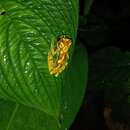Description
provided by AmphibiaWeb articles
A highly colorful treefrog with variable coloration and patterning and large eyes. Boulenger (1899) noted that the type specimen is female and measures 59 mm SVL. Head is large and depressed, slightly broader than long. Interorbital space equal to length of upper eyelid. Snout length equal to the diameter of the orbit. Canthus rostralis indistinct. Loreal region oblique and somewhat concave. Nostrils are near the tip of the snout. Tongue is circular and almost entirely adherent. Very large choanae. Vomerine teeth present in two strong angular series between the choanae. Tympanum is distinct, with a diameter slightly shorter than the diameter of the eye. Limbs are slender. Fingers have discs equal in size to the tympanum. Outer fingers are one-third webbed. No distinct pollical rudiment present. Toes are three-fourths webbed. Tibiotarsal articulation reaches just beyond the tip of the snout. Tibia are three-fifths the length of the head and body combined. Dorsum is smooth; belly and ventral surface of thighs are weakly granular. No dermal appendages (Boulenger 1899). In preservative, the type specimen has a violet dorsum, with cream-colored spots bordered with purplish-red; the cream spots are arranged in symmetrical groups, one on the head and nape, a second group anterior to the sacrum and a third on the coccygeal region. A white transverse band runs between the eyes, interrupted in the middle. The lores and temples are whitish and have reddish markings. Limbs are creamy white dorsally and have violet crossbars alternating with narrower purplish-red crossbars. The humerus and concealed surfaces of the hind limbs lack color. Ventral surfaces are white (Boulenger 1899).Species authority: Boulenger (1899), as Hyla picturata. The type specimen is held in the British Museum (BM 1947.2.13.35), according to Condit (1964) and Duellman (1977). In the Hypsiboas punctatus group, according to Faivovich et al. (2005). These authors resurrected the genus Hypsiboas, and noted that H. picturatus was the only colorful member of the H. punctatus group, an otherwise green group of hylids; the group was diagnosed by 30 transformations in mitochondrial genes, both protein-coding and ribosomal, rather than by morphological characters. H. punctatus itself has also been reported to be very variable in color, although it is primarily green (see Nascimento et al. 2009 for a discussion). Lutz and Lutz (1973) noted that Ecuadorian Hypsiboas picturatus (then known as Hyla picturata) resembled the most ornate individuals of Brazilian Hypsiboas geographicus (then known as Hyla geographica). Previously Hypsiboas picturatus had been included in the Hyla geographica species group (as Hyla picturata), most recently by Duellman and Hoogmoed (1992), but Faivovich et al.'s (2005) analysis found the Hyla geographica group to be polyphyletic and placed H. picturata in a monophyletic clade including the former Hyla punctata and Hyla granosa species groups.
- Bolívar, W., Coloma, L. A., Ron, S., and Cisneros-Heredia, D. 2004. Hypsiboas picturatus. In: IUCN 2010. IUCN Red List of Threatened Species. Version 2010.2. www.iucnredlist.org. Downloaded on 11 July 2010.
- Boulenger, G. A. (1899). ''Descriptions of new batrachians in the collection of the British Museum (Natural History).'' Annals and Magazine of Natural History, Series 7, 3, 273-277.
- Condit, J. M. (1964). ''A list of the types of hylid frogs in the collection of the British Museum (Natural History).'' Journal of the Ohio Herpetological Society, 4(4), 85-98.
- Duellman, W. E., Hoogmoed, M. S. (1992). ''Some hylid frogs from the Guiana highlands, northeastern South America: new species, distributional records, and a generic reallocation.'' Occasional Papers of the Museum of Natural History, University of Kansas, 147, 1-21.
- Nascimento, F. A. C., de Lima, M. G., Skuk, G. O, and de Sá, R. O. (2009). ''The tadpole of Hypsiboas atlanticus (Anura, Hylidae) from northeastern Brazil.'' Iheringia. Série Zoologia, 99, 431-436.
- Ortega-Andrade, H. M., Bermingham, J., Aulestia, C., and Paucar, C. (2010). ''Herpetofauna of the Bilsa Biological Station, province of Esmeraldas, Ecuador.'' Check List, 6(1), 119-154.
- Vargas, S. F., Bolaños, M. E., and Berrío-B., H. (2000). ''Notas sobre la ecología reproductiva de Agalychnis spurrelli (Anura: Hylidae) en una población de Anchicayá, Pacífico Colombiano.'' Revista de la Academia Colombiana Ciencias Exactas, Físicas y Naturales, 24, 85-99.
Distribution and Habitat
provided by AmphibiaWeb articles
Found in southwestern Colombia and northwestern Ecuador, in the Pacific lowlands, from 50-500 m asl (Bolívar et al. 2004). The type locality is "Paramba, [Provincia Imbabura,] N. W. Ecuador" (Boulenger 1899). It has also been reported from Canandé (Provincia Esmeraldas) and Mashpi (Provincia Pichinca) in Ecuador (Cisneros-Heredia et al. 2009), and Anchicayá, Colombia (Vargas et al. 2000). It is found associated with streams in closed-canopy forest, or occasionally in secondary forest adjacent to closed-canopy forest (Bolívar et al. 2004).
Life History, Abundance, Activity, and Special Behaviors
provided by AmphibiaWeb articles
Uncommon according to Bolívar et al. (2004) but can be locally abundant. Ortega-Andrade et al. (2010) reported that this nocturnal species was one of the most abundant amphibians in forested areas having streams or waterfalls, near Bilsa Biological Station (Esmeraldas Province), Ecuador. At Anchicayá, Colombia, two individuals were found on leaves overhanging streams, at 40 and 200 cm above the water respectively (Vargas et al. 2000).
Life History, Abundance, Activity, and Special Behaviors
provided by AmphibiaWeb articles
This species is declining, although it is considered Least Concern (Bolívar et al. 2004). Its range overlaps with at least two protected areas in Ecuador, Parque Nacional Mache Chindul (which includes the Reserva Biológica Bilsa) and Reserva Ecológica Cotacahi-Cayapas (Bolívar et al. 2004).
Imbabura tree frog: Brief Summary
provided by wikipedia EN
The Imbabura tree frog (Boana picturata) is a species of frog in the family Hylidae found in the Pacific lowlands of western Colombia (Antioquia, Valle del Cauca, Cauca, and Nariño Departments) and northwestern Ecuador (Imbabura, Esmeraldas, Manabí, Pichincha, Santo Domingo de los Tsáchilas, Los Ríos, and Cotopaxi Provinces) from the sea level to 1,000 m (3,300 ft) asl.
- license
- cc-by-sa-3.0
- copyright
- Wikipedia authors and editors

